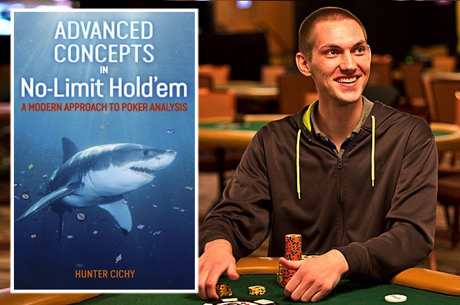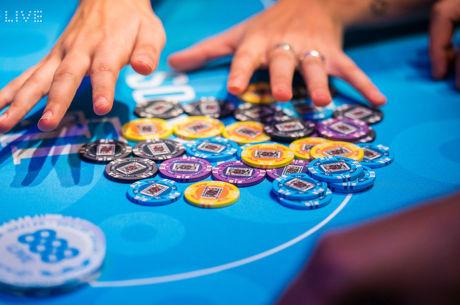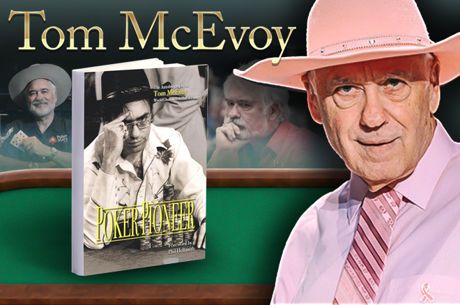PokerNews Book Review: 'The Microstakes Playbook' by Nathan Williams

Like many up-and-comers in the early 2000s, Nathan "Blackrain79" Williams found poker as a broke kid in his early twenties, fresh out of university and with little direction. From there Williams embraced the life of a jetsetting grinder, traveling the world and amassing "some of the highest winnings in online poker history." (How high? He doesn't say.)
Unlike Ben "Sauce123" Sulsky, Doug "WCGRider" Polk, and others who grinded from nothing to the nosebleeds, Williams focuses exclusively on the microstakes. In The Microstakes Playbook: Simple Poker Strategies for Massive Success — his third book — Williams's goal is "to get you winning big against the weak opponents at the lower limits, either online or live, and then quickly moving up the stakes."
Playing the Player
A huge part of winning poker, Williams says, can be summed up as "consistently exercising your skill advantage over weaker opponents and not handing that profit back to them by going on tilt when they get lucky." He stresses "player profiling," or tailoring strategies to six kinds of opponents:
- 1) Nits and 2) Tagfish (bad regulars)
- 3) Tags and (4) Lags (good regulars)
- 5) Whales and 6) Maniacs (recreationals)
These player types are determined by basic HUD stats like VPIP (percentage of hands played), PFR (percentage of hands raised preflop), 3Bet (percentage of the hands reraised preflop), and AF (aggression factor). And, of course, by paying attention.
Seeking "The Great Play"
A Nit raises from early position. You decide to three-bet from the button with two queens — the third strongest hand in hold 'em! — and the Nit four-bets. Now what?
"When a tight player like this opens from early position this indicates a strong range," Williams says. "But we still went ahead and 3Bet him anyways. So this play shows even more strength given the situation. And yet despite all of this, this tight passive Nit still decided to take the ultra aggressive action of 4Betting us!"
How does QQ fare against a Nit's early position four-betting range?

Grim news.
"As crazy as it might sound," Williams writes, "unless the stacks are super deep (200bb+) we should just go ahead and fold our hand. We cannot stick 1/4 of our stack in the middle here as a massive underdog and expect to turn a long term profit."
Reraising a Nit with two queens was "the average play." Williams advocates for a flat-call — "the great play" — which increases the likelihood that you'll play the pot in position and keep your opponent's range wide:

Throughout his discussion, Williams seeks the most profitable action against a specific player type. As he rightly says, at the micros there's no other strategy that even comes close to being as effective.
With exploitative play as its main focus, the 271-page book is organized into 22 sections:
- How to Create Custom Opening Ranges
- Picking up the Easy Money Before the Flop
- Crushing the Regs in 3Bet Pots
- How to Defend Against 3Bets Effectively
- How to Dominate 4Bet Pots
- Betting the Flop Like a Pro
- Floating Their CBets Like a Champion
- Raising Them All Day on the Flop
- The Subtle Art of Dominating 3Bet Pots on the Flop
- Firing the Second Shell and Making Them Fold
- Double Floating - The Secret Weapon
- The Turn Bluff Raise: Owning Their Soul
- Triple Barreling - The Strongest Play in the Game
- The Stop and Go Value Bet
- The Stop and Go Bluff
- The River Bluff Raise
- The Thin River Value Raise
- The Big Call - Neutralizing Their Aggression
- How to Study Your Poker Game and Plug Your Leaks
- Playing in the Right Poker Games - Finding the Fish
- Poker Finance - The Pro's Edge
- The Mental Advantage - Unbreakable
Many of these sections contain helpful strategies that can be used against weaker players. For example, in "Betting the Flop like a Pro," Williams argues that if you're the preflop raiser, as you often should be, then you should continuation bet most flops. Why? Because the players who might punish you for betting too much — by floating the flop or check-raising with a balanced range — simply don't exist in the micros.
In other words, play the player. Weaker regulars — Nits or Tagfish — will often fold to a flop c-bet 70-80 percent of the time. As a result, c-betting will print money versus them. The same is true against call-happy recreational players.
"Although they [the recreationals] won't fold anywhere near as often, I will still be firing a CBet most of the time," Williams explains. "The key thing to remember here is that since our CBet size will only be 50% or 60% of the pot, mathematically we only need to get folds about 1 in 3 times in order to turn a profit. Even the craziest fish out there tend to fold that often."
Practice, Theory, and Moving Up in Stakes
At times, the book could use more in-depth analysis and precision. For instance, in another section, "Dominating 4Bet Pots," Williams discusses four-betting LAGs and TAGs — the only players who three-bet wide enough to make four-betting profitable. The key to dominating them, he says, is to "employ a roughly 2:1 ratio of value hands to bluffs."
But why? Why not a 1:1 or a 2:1 ratio of "value" to "bluffs"? (I'm using scare quotes because, as Matthew Janda has pointed out, these are poor terms for describing hand ranges preflop, since any hand has at least some equity.) There's no explanation of why a 2-to-1 ratio is important or why, in theory, some betting frequencies work better than others.
"This book is not theory," Williams says. "It is instead a practical guide based off of millions of hands that I have played at the micros."
Theory's one thing; precision is another. Against a three-betting TAG or LAG, Williams says, your four-betting range should look like this: AA, KK, QQ, JJ, TT, AK, AQ, A5s, A4s, A3s. That's 62 hands for "value" and 12 suited aces for "bluffs" — much closer to a 5-to-1 ratio than a 2-to-1 ratio. (This disparity isn't explained.)
A challenge of writing a comprehensive book about no-limit hold 'em is that advanced topics are often simplified. For Williams, simple strategies are enough to crush the micros.
"You just have to be willing to put in the most basic effort," he says. "Most people don't study their game at all, they sit down and play at any random poker table, they manage their bankroll poorly and they tilt like crazy when a little bit of adversity strikes. The most basic improvements in these areas can yield you a massive edge over your competition in today's games."
Even if this is true at the micros, "the most basic effort" will hardly cut it in higher-stakes games.
Is The Microstakes Playbook valuable? It depends on your goals. If you're a member of Williams's target audience — an online poker player who wants to beat lower limits — then the book offers a nice foundation. Players who want to move up in stakes quickly, whether online or live, might choose to consult other, more rigorous resources.
The Microstakes Playbook: Simple Poker Strategies for Massive Success by Nathan Williams is available via BlackRain79.com.
Ben Saxton is a teacher and a writer from upstate New York who has played small stakes poker, both live and online, since the early 2000s. Ben lives in New Orleans and covers poker on the Gulf Coast.









